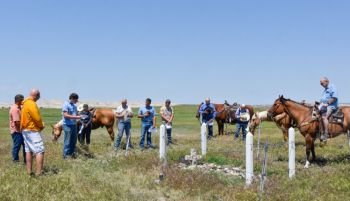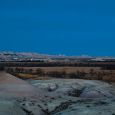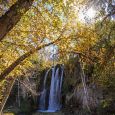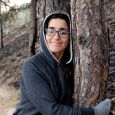The Gift of South Dakota
Subscriptions to South Dakota Magazine make great gifts!
Subscribe today — 1 year (6 issues) is just $29!
A Tradition of Stewardship
Aug 4, 2021
On a Sunday in June, a group of former Boy Scouts and troop leaders gathered at an austere grave site, hidden in a corner of Badlands National Park, and commemorated the interred with a Psalm reading and a chorus of “The Old Rugged Cross.”
The grave is where the Tyree family — who homesteaded in the Tyree Basin before it became incorporated into a national park — buried Eugene Tyree, who lived only a few hours after his birth in 1916. His twin brother Howard survived.
The Tyrees migrated to this arid landscape from West Virginia in 1911. James Tyree, son of Howard, recalls stories his father told him of how they lived here. "They attempted to do a little bit of everything," he says. "They captured wild horses and broke them, sold them to the military. They did some work for the railroad. Back then they used to have problems with the coal-fired trains starting fires on either side of the track. They would have people that would take a big drag line, like a farming disk — I heard they were twenty or twenty-five feet wide, and they were usually pulled by a six or eight horse team — they would go out to a certain point on the railroad line and drive till the end of the day. Then at the end of the second or third day, they crossed the tracks again and came home the next day."
Howard Tyree was the youngest of seven children. At some point, the family moved closer to the town of Conata. "I was told that Conata was a place where they had early rodeos, that were just out in the plains, in the open," James Tyree recalls. "They didn't have the big bleachers and gates and stuff like that. My dad was quite a horseman. He was kind of a horse whisperer. There never was a horse that he couldn't train. In the rodeo he did the bulldogging, bronc riding, bull riding, calf roping, whatever.
"He got disqualified one year out there from calf roping. He had adapted a method of throwing his rope underhanded and he could catch three feet in one loop, yank him up. And then when the calf was in the air, he'd throw two half hitches overhand and tie the knot. So he never got off his horse. He was disqualified for that, which was rather unique."
Eventually the family moved to Minneapolis. Howard Tyree and the other Tyree brothers enlisted in the service (Howard in the Air Force) during World War II. Later, Howard ran a small ranch in Golden Valley, Minnesota, where James was raised.
In 1954, Howard Tyree drove his family out to the old homestead and visited the grave site of his twin brother, Eugene, marked only by a pile of rocks. "He took a bottle," James says, "and he wrote a note identifying the site and set it in the pile of rocks. Sometime later the Boy Scouts came along and they found the grave site and they contacted my dad."
Bill Tines was part of that scout troop, based in Wasta. "The Scout leader was George 'Junior' Gunn. His dad had homesteaded not very far from the Tyree grave and Junior knew about the grave. And somehow our Scout leaders decided that'd be a good project for us to fix up his grave. So probably in the late fifties or so we went down and we found the grave and we put the posts up and the cross and everything."
"My dad and [his brother] Roy went up there for that," James Tyree recalls. "And a few years later, when I was older, they had a reunion out there from the group that took care of the grave site. My dad, Roy and I went out there, around 1960, and we rode horseback in there and spent a few days out there."
Over the years, Scouts became troop leaders. Wasta could no longer support Troop 30. Bill Tines moved to New Underwood and led the Troop there. The tradition of stewardship over the infant's grave continued, as did the relationship with the Tyrees.
When Howard Tyree passed away in 2007, James Tyree, accompanied by his son Danton, honored his request to scatter his ashes at the site of his twin brother's grave. Bill Tines and several generations of Scouts joined the family at the memorial.
Last year, Sioux Falls resident Lance Smith was running the unmarked Sage Creek Wilderness Loop in the Badlands when he came across the lone grave site. He made it a personal mission to do some maintenance and set out to contact the Tyree family.
In May, Smith and some other volunteers, accompanied by Danton Tyree, Bill Tines and some former Scouts, made the trip to repair the fence — which bison use as a scratching post — around the site. Many of them returned for the reunion and memorial service, more than 60 years after Junior Gunn decided to improve upon the Coke bottle and note left by Howard Tyree.
"They always say things happen and you wonder, 'Lord, why do you do this?'" Tines says. "I'm sure when that little baby died, they thought, 'Lord, why do you do this?' Well, a hundred years later, there's people going down to take care of that grave. We'd like some of these young kids from these families that have been down there to kind of take it over and keep it going. There's four generations in my family that have gone down there to the grave and took care of it."
"There's so much I don't know, or didn't know, about my grandfather and his growing up that this all kind of brought up," says Danton Tyree. “So hearing stories with the Scouts has been fun, and hearing those things from my dad specifically. Sometimes you don't start thinking about those things until they're gone."
"Not very many people have their name on a map, where there's significance to the land, from your ancestors. There's not a lot of people that can have that connection. And for me it was kind of lost. Then when Lance came around, he just completely reinvigorated the whole thing for our family. There's a lot of grave sites out there. And for this one, for some reason, to draw the interest that it has, it has certainly benefited me and my family."
Michael Zimny is a content producer for South Dakota Public Broadcasting and is based in Rapid City. He blogs for SDPB and contributes columns to the South Dakota Magazine website.











Comments
Aunt Mary was born in 1930 and lived her whole life in Western South Dakota. She always loved to roam the prairie and the Hills, and as a young woman she stumbled across the marker in question. From the dates, it was clear it was a child's marker (Philip Fettig was born October 5, 1912 and died September 7, 1915, shortly before his 3rd birthday). The memorial inscription is in German and because that was the first language of both her parents (2nd generation Americans, born to German emigrant parents), she was drawn to save the marker. It was broken in two pieces, and no grave was discernable, so she felt the good of this act outweighed the negative. She brought it home and placed it in her yard, often planting annuals around it although she wasn't much for gardening.
I felt compelled by my German heritage to not only learn German - my father had not learned it from his parents, as his mother died when he was 7 and his sister, my aunt, was 12 - but to go the extra mile and major in German Studies at Stanford U. My aunt and I were kindred spirits and became especially close in the last decade and a half of her life. Because of this, and the marker's German inscription which I translated for her, she eventually entrusted the grave marker to me and it came out to Oregon. It is currently standing under a lilac bush at my seaside home.
I do a Google search every once in a while to see if I can find any records of a Philip Fettig or his family in western South Dakota, but so far without success.
Mary's own gravestone is an interesting story, too - it is a sundial in coffin-shaped Keystone cemetery!